Authors): A.N. Gerke, Ph.D., veterinary dermatologist, member of the European Society of Veterinary Dermatologists (ESVD) / A. Gerke, DVM, PhD
Organization (s): CJSC "Network of veterinary clinics", St. Petersburg / "Network of veterinary clinics", St. Petersburg
Magazine:
№1 - 2013
Abbreviations : APTI - fine needle aspiration puncture; i / m - intramuscularly; s / c - subcutaneously; p / o - inside; GCS - glucocorticosteroids
Erosions and ulcers can be a manifestation of various skin diseases in cats. Erosion ( erosio) - a superficial defect within the epidermis (epithelium), can be found on the skin and / or mucous membranes. They appear with mechanical irritation of the skin - as a result of scratching (excoriation) of a papular rash, with maceration of the epidermis of the skin in the area of \u200b\u200bfolds (intertrigo-complex). Also, erosion is formed when the bubbles, blisters and superficial pustules are opened. Many immune-mediated diseases, accompanied by vesicular-bullous lesions, go unnoticed by the owners until they are eroded. They are usually found in areas with sparse hair (abdomen, temporal areas). Erosions are usually bright red, often covered with secretions or crusts. A distinctive feature of erosions is healing without scarring. Sometimes temporary pigmentation appears in their place, less often hypopigmentation. Erosion causes an itching sensation, sometimes even pain. Cats intensively lick the affected area, maceration and infection lead to the development of ulcers.
Ulcer ( ulcus) - a deep defect in the skin, and sometimes subcutaneous tissue. Acute ulcers are usually shallow, usually round or oval in shape, their edges do not rise above the level of the skin or mucous membrane. The edges of a chronic ulcer are often raised, dense, sometimes callous (callous ulcer). The bottom, or base, of the ulcer is clean, bleeding or festering, covered or uncovered with granulations. In a number of diseases, it is covered with necrotic decaying masses. With pronounced cicatricial changes in the region of the edges and bottom, ulcers often acquire a kind of stellate outlines. Subsequently, a stellate scar can be found in their place. Skin ulcers are a polyetiological disease, they can occur as a result of the development of infection (bacterial, viral, fungal), mechanical, thermal, electrical, chemical factors, ulceration of tumors.
Diagnosis of erosive and ulcerative dermatoses is carried out on the basis of medical history, dermatological examination, including the study of deep scrapings from the skin, and routine blood tests. Anamnesis should not be neglected when examining cats, for example, the development of skin ulcers can be caused by a direct damaging effect during thermal damage, as a result of exposure to acids, caustic alkalis, etc.
Cytological examination of scrapings and material obtained by fine needle aspiration (APTI) should be carried out at the initial stage of the diagnostic examination (before the use of therapy). This allows for a quick result and early diagnosis of cutaneous neoplasia, although the absence tumor cells in the material does not exclude its presence.
It is necessary to carefully select for research the most recent affected areas (usually at least three) that are not prone to excoriation (combs). In ulcerative dermatitis, it is preferable to find primary lesions that are a direct result of the pathological process and provide the most information. Before taking scrapings, purulent-necrotic masses must be removed from the surface of the lesions with a cotton swab (gauze cloth). The material is scraped off with a scalpel blade until capillary blood appears. Then it is evenly distributed over the slide and air-dried.
Methods of processing and coloring smears, punctates and prints are very diverse (according to Pappenheim, azure-eosin according to Romanovsky, according to Leishman, hematoxylin-eosin, fast Diff-Quick paints and others).
In hematological blood tests of cats with erosive-ulcerative lesions, attention is paid primarily to the number of leukocytes and leukogram: leukopenia is observed in viral diseases (calicivirus, immunodeficiency of cats, etc.), eosinophilic leukocytosis - with increased sensitivity to flea bites, atopy, eosin granulomas, especially with the presence of ulcers in the oral cavity, less often food allergies, urticaria pigmentosa and mastocytomas.
Biochemical blood tests are often used to diagnose systemic abnormalities to rule out diabetes, kidney and liver failure. The identification of these metabolic abnormalities limits the physician's choice of medications, thus avoiding complications when treating sick cats. When diagnosing skin diseases of an erosive and ulcerative nature, attention is paid to the proteinogram, especially to the content of immunoglobulins - severe hypergammaglobulinemia is observed with long-term allergic diseases, for example, atopy.
Diseases of an immune nature
The eosinophilic granuloma complex is the most common erosive-ulcerative skin disease in cats, affecting the skin and oral cavity (photo 1). Clinically manifested by ulcers, plaques, linear granulomas, miliary dermatitis (photo 4). A large number of eosinophils and histiocytes is observed in cytological preparations (photo 3). To obtain informative material, it is necessary to carry out scrapings from the freshest areas of the lesion. In cases of infected erosion, the examination of the material reveals degenerative neutrophils, microbes, and cell detritus. Smears-prints of superficial exudate almost always contain many bacteria and leukocytes, which indicates the colonization of opportunistic microorganisms in the ulcerated lesion.
With plasmacytic pododermatitis, cytology of aspirates obtained from eroded granulomas located mainly on the pads of the paws reveals a large number of plasma cells.
Mixed inflammatory cells, represented by non-degenerative neutrophils and macrophages, the presence of a large number of acantholytic cells (rounded nuclear keratinocytes, devoid of cytoplasmic processes) is characteristic of an autoimmune process (for example, pemphigus leaf - photo 6).
At the beginning of treatment, it is necessary to use mechanical means of protection to prevent self-injury. This can include an Elizabethan collar, lightweight coveralls, soft polymer claw caps, and other gadgets.
Corticosteroids and immunosuppressants are used to treat immune-mediated erosive-ulcerative dermatoses in cats. Corticosteroids have a rapid anti-inflammatory, anti-edematous, antipruritic effect, inhibit the release of cytokines (interleukins and interferon) from lymphocytes and macrophages, inhibit the release of inflammatory mediators by eosinophils, disrupting the metabolism of arachidonic acid and the synthesis of prostaglandins, reduce anti-inflammatory and cellular infarction ... lymphocytes in the area of \u200b\u200binflammation.
Prednisolone is prescribed p / o at 1 - 2 mg / kg every 12-24 hours, this interval gradually increases to 48 - 72 hours. It is important to continue treatment for at least a week after a visible remission is established. If it is impossible to give tablets, you can use prolonged injectable corticosteroids: dexamethasone 1 - 2 mg (Dexafort, MSD Animal Health, s / c, i / m at a dose of 0.3 - 0.7 ml) , methylprednisolone acetate (Depo-Medrol, PFIZER) is administered intramuscularly at a dose of 0.25 - 0.5 ml (10 - 20 mg per cat), triamcinolone (Kenalog, Polcortolone 40 - intramuscularly 0.2 - 0.5 ml per cat). After the introduction of GCS, in most cases, improvements are observed within 12 - 48 hours, and the effect lasts for several days or even weeks. However, in view of the risk of developing diabetes mellitus and immunosuppression, it is advisable to avoid the frequent use of prolonged injectable forms. In addition to steroid medications, antihistamines and fatty acid supplements may be used. For humans, antihistamines in mono-mode, including local ones, are considered effective, but, according to the author's experience, they are of limited value for cats, although in some cases they reduce the need for GCS.
If it is impossible to exclude the effect of the allergen and the recurrence of the disease with a decrease in the dose and frequency of administration of GCS, a combination therapy with the use of cytostatics is used.
Drugs in this group are used to treat cats with pemphigus and eosinophilic granulomas that do not respond to GCS therapy. Chlorambucil (Leukeran) is used more often in doses of 0.1-0.2 mg / kg (2-4 mg / m2 of body surface) daily or every other day. Symptoms of lesions of the gastrointestinal tract (anorexia, vomiting, diarrhea) occur less frequently when administered every other day. Myelosuppression disappears after drug withdrawal. The course is usually 1 - 2 months, then the dose can be reduced until the drug is discontinued. When treating animals with drugs of this group, it is recommended to control clinical analysis blood count, including platelet counts, every 2 weeks.
In eosinophilic dermatitis, cyclosporin at a dose of 2.5 mg / kg / day has been successfully used. In severe cases, the dose may be increased to 5 mg / kg / day. When a positive clinical result is achieved, the dose must be gradually reduced until it is completely canceled.
Bacterial skin infections
Primary bacterial skin infections are rare in cats (with the exception of trauma subcutaneous abscesses) and are usually associated with immune and metabolic disorders. Predisposing factors are allergies (photo 2), hyperthyroidism, diabetes mellitus, immunosuppression (FIV, FLV, calicivirus and others). An exception is superficial pyoderma in kittens (juvenile impetigo) with excessive grooming. The main microorganism that causes pyoderma is recognized as coagulase-positive Staphylococcus pseudointermedius, and Pasteurella multocida, Streptococcus sp.(hemolytic strains) , Actinomyces sp., Bacteroides sp., Fusobacterium sp.
In cytological preparations for pyoderma, there is a marked increase in the number of neutrophils, including the presence of degenerative leukocytes, some of which may contain intracellular bacteria. Eosinophils are rare. The presence of yeasts is also possible Malassezia sp.,especially with an intertrigo complex.
Treatment consists of elimination of the causes and antimicrobial therapy. Only local application of drugs (chlorhexidine, miramistin, povidone-iodine and others) is effective in eliminating the causes of erosive lesions. In case of ulcers, systemic antibiotic therapy is required: amoxicillin + clavulanate 12.5 - 25 mg / kg po every 12 hours, cephalexin 25 mg / kg po every 12 hours, enrofloxacin 5-10 mg / kg po every 12 hours and others. In chronic cases, the material can be sent for microbiological examination (isolation of bacterial and fungal cultures and an antibiotic susceptibility test).
Neoplasms
Proliferative ulcerated skin lesions in cats, especially solitary ones, should always be alert to neoplasia. Blastomatous ulcers are formed as a result of the breakdown of tumor tissue. Cytological signs of malignancy of neoplasms are: anisocytosis (change in cell size), pleomorphism (change in the shape of cells), change in the intensity of color of the cytoplasm, anisocaryosis (change in the size of nuclei), change in the size and shape of nucleoli, change in the value of the ratio nucleus / cytoplasm. The most common examples of tumors leading to the formation of ulcerative skin lesions in cats are basaliomas (photo 5), squamous cell carcinoma, mastocytomas (photo 9), less often ceruminomas and tumors of the sebaceous glands, tumors of mesenchymal origin (fibrosarcomas, angiosarcomas, and others). Erosions and ulcers in the abdomen, accompanied by indurations in and under the skin, are often associated with breast carcinomas (Fig. 7).
Mycoses
Fungal infections rarely lead to ulcerative skin lesions in cats. Candidiasis of the mucocutaneous zones is a rare cause of erosion associated with wet maceration of the skin. However, defeat Candida spp. must be considered when differential diagnosis eosinophilic ulcers on the lips in cats; this mycosis occurs against the background of immunosuppression, incl. caused by the unreasonable use of GCS. In cytological preparations, typical budding yeast fungi are revealed, while a weak leukocyte reaction is observed.
Dermatophytosis rarely leads to the development of erosions and ulcers, however, excoriation, especially in kittens, can manifest itself as erosions in the head area (photo 8). The rarest cases of pseudomycetoma in the region of the trunk and base of the tail in the Persians also appear as ulcerated nodules on the skin.
Treatment is carried out in a comprehensive manner, combining local administration of drugs (for example, povidone-iodine) and elimination of the causes of mycosis. In the absence of improvement and / or generalization of lesions, systemic antimycotic therapy is used (intraconazole po 10-20 mg / kg every 24 to 48 hours, ketoconazole 5 to 10 mg / kg every 12 to 24 hours).
Scabies of cats
Notoedrosis, or itchy scabies, is characterized by itching, poorly controlled by GCS, papules and crusts. Erosion is possible due to excoriation and self-licking. The diagnosis is based on the detection of mites in the scrapings. An improvement in the cat's condition is observed after treatment with acaricides (topical amitrazine, ivermectins, selamectin, etc.). The duration of treatment is at least four weeks, the first 7 to 10 days, it is possible to use GCS to reduce itching.
In conclusion, we can say that the factors that cause the formation of erosions and ulcers on the skin in cats are extremely diverse. Often, their appearance is due to the combined effect of both general and local factors. An example of such ulcers is pyoderma against the background of allergic eosinophilic syndrome. Therefore, the effectiveness of treatment directly depends on the correct diagnosis.









The appearance of sores on the neck in a cat is associated with the presence of a primary infection. The animal itches, shows nervousness,. Before starting treatment, you must first find out the reasons.
Why does a cat have sores on its neck and itch?
Sores on the neck can cause a lot of trouble for a cat.
The most common of these is the subcutaneous scabies mite. Depending on the type of mite, the disease is called notoedrosis or sarcoptic mange. And in fact, and in another case, the treatment is the same.
Allergy in cats
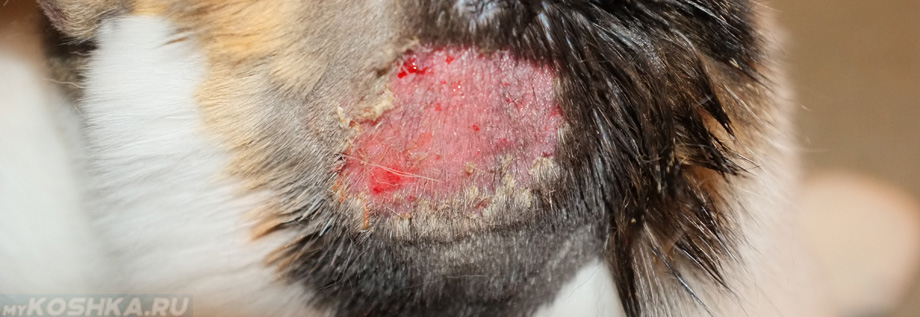
This sore was small, then the cat scratched it because of severe itching.
Allergy can also serve as a causative agent - food or dust... Sores are first localized on the neck, then go to the chin and forehead. They look like dried crusts, then, when the animal begins to lick them, they get wet and become wounds. does not seem possible. To identify an allergen, you should go to the clinic for laboratory tests.
Fleas
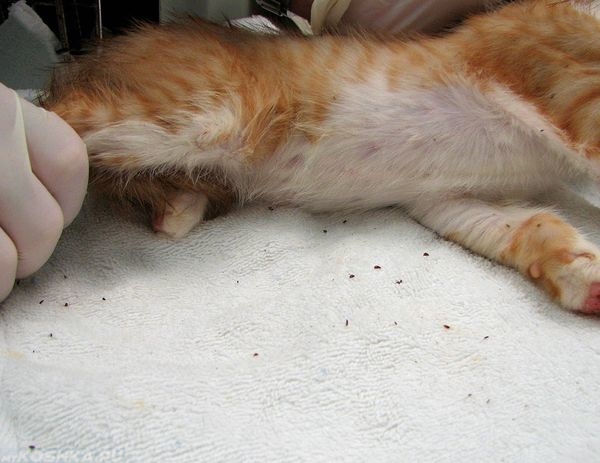
Another important factor is. Insect bites are brushed to blood by the cat, which leads to wounds, which, in turn, become inflamed, providing favorable environment for the reproduction of pathogens.
Bacterial dermatitis
Bacterial dermatitis is another cause of neck wounds.

Neck wound due to irritation from bacterial dermatitis. Cat from a for severe itching he constantly scratches the wound. A big sore formed.
The advanced stage of the disease leads to more severe consequences: fistulas, nodes,. Bacterial dermatitis is often a secondary pathology caused by diseases such as endocrine disorders of the body, allergies.
How to treat sore neck at home
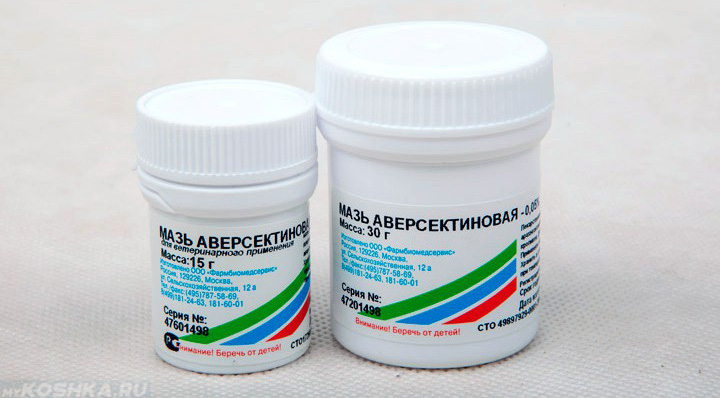
If a subcutaneous tick is found in a cat, the following measures are taken:
- isolate the animal;
- cut off the affected area of \u200b\u200bwool;
- wash with keratolytic shampoo;
- apply aversectin ointment;
- prescribe the drug "Advocate" in the form of drops;
- use sulfuric ointment;
- dripping drops of "Amit Forte";
Starting treatment, you should thoroughly disinfect all pet toys, habitats, bedding, utensils.
Allergy
Allergy can be to saliva fleas, food, atopic dermatitis ... An allergic reaction to flea saliva can be easily treated with topical insecticidal treatments. Drops, sprays, collars, powder are recommended.
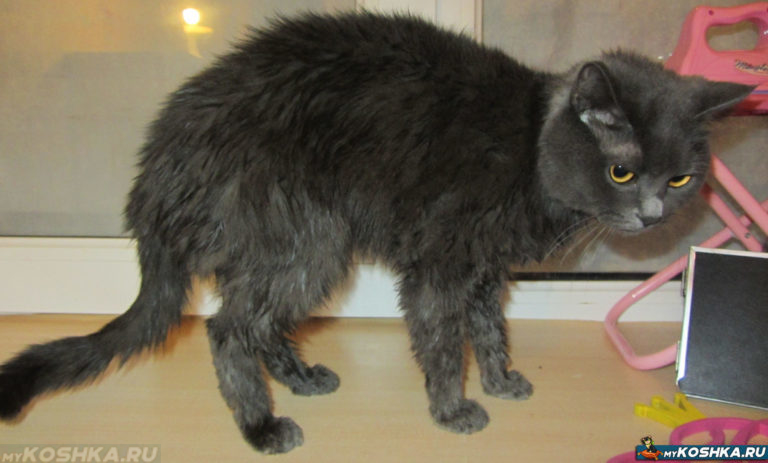
Bathing with medicated shampoos is indicated to treat sources of itching.
Eliminated by excluding dangerous products from the diet. The use of symptomatic therapy, cleansing agents for the body is recommended. Shown, the appointment of steroid, antihistamines. Antibiotics are prescribed to treat scratching, preventing the risk of contracting other infections.
There is no one hundred percent cure for atopic dermatitis.
Pathology of a genetic nature and the periodic manifestation of relapses and new outbreaks of the disease are almost guaranteed. It often runs latently and is imperceptible until complications appear. Supportive therapy, control of the occurrence of secondary infections based on atopic dermatitis is recommended. A cat with this type of allergy will have to maintain its body throughout its life.
Flea control
There are various topical preparations available to combat fleas.
Can be used powders for kittens , but use with extreme caution, as they are often toxic and irritating to respiratory system... For adults over six months old, collars are used. The collar lasts up to three months. The most effective remedy is drops on the withers.
Most often used frontline - eliminate fleas within a day, prevent the appearance of insects for two months. Hartz drops have good recommendations. Affects flea eggs and larvae. Before use, the animal must be bathed with a flea shampoo.
Suitable for cats in contact with other animals. Drops advocate are useful not only against fleas. The destructive effect is produced on ticks, worms are removed. Stronghold and leopard drops are also recommended. Frontline spray will have a positive effect.
Dermatitis
There is no single correct treatment regimen for bacterial dermatitis.
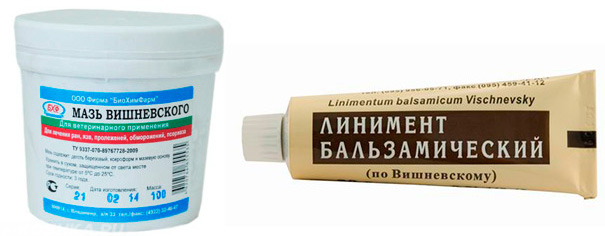
Treating bacterial dermatitis is difficult. But preparations based on Vishnevsky Ointment have proven themselves well.
Help will be based on the primary cause. In the case of a traumatic type, the affected areas are treated with a solution of iodine, methylene blue. Prescribe lotions with astringents, compress using vishnevsky ointment .
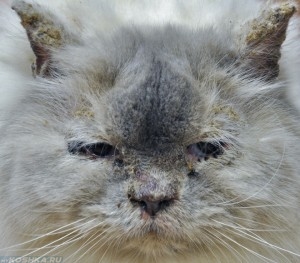
Purulent dermatitis causes crusty sores.
Treatment of purulent dermatitis includes cutting the hair of the sore spot, removing dried crusts, and treating with antiseptics. Sprinkle with streptocide powder, antibiotic. For a more severe or advanced form, antibiotic injections or oral administration are prescribed.
Take over several weeks. The medicine is indicated for use in tablets Ivermectin, Milbemycin. The course of admission is calculated for three months. It is recommended to bathe your pet in a solution from ticks, regular washing with medicated antibacterial shampoos.
Preventive actions
When talking about the prevention of skin diseases, special attention should be paid to vaccination.
The animal must be vaccinated without fail, then the risk of infection will decrease, and immunity will increase. Vaccinations must be done strictly according to the schedule established by the doctor. Mandatory preventive examination, full comprehensive examination.
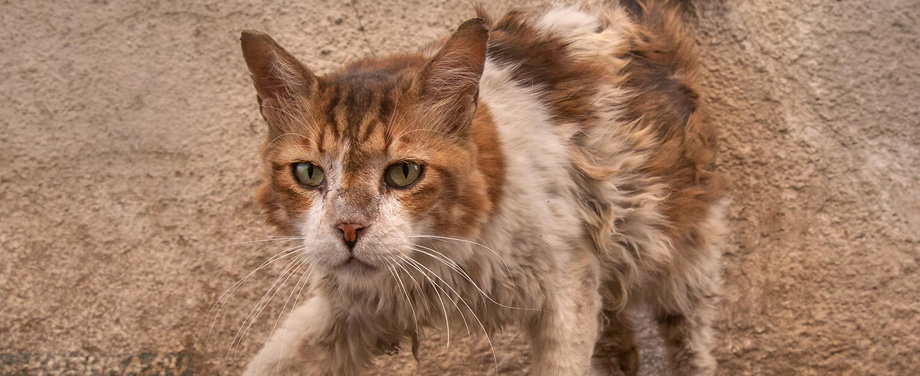
Avoid contact with street cats.
The cat's habitat should be disinfected periodically. Treat against ticks, worm infestations, fleas and other insects. The pet's dishes must be kept perfectly clean, the tray must be cleaned and disinfected on time.
Keep your cat out of contact with other animals, possible vectors of diseases. Meat and fish products should not be given raw to avoid the risk of infection with helminths. Strictly control the quality of the animal's nutrition, do not introduce into the diet obviously dangerous or suspicious foods to which the cat may develop an allergic reaction.
Avoid "random food" - trash cans, buckets. Observe all standards of sanitation and personal hygiene of your pet.
The skin performs not only protective functions, protecting the muscles and internal organs from injury. It is a barrier to billions of pathogens that can compromise your pet's health. Therefore, any skin disease in cats should be taken seriously: unhealthy skin is the gateway for bacteria, viruses and other pathogens of many diseases.
In addition to the protective function, the skin takes part in the synthesis of various vitamins, provides thermoregulation and removes toxins from the body. Diseases of the skin in cats negatively affect health in general: immunity decreases, the work of internal organs and all systems deteriorates. Therefore, if you notice any changes in the condition of the skin, whether it is ulcers in cats on the skin or a seemingly harmless rash, you should consult a specialist.
There are dozens of skin diseases and hundreds of forms of their manifestations. Many are symptomatically similar so much that even an experienced doctor does not immediately correctly diagnose the disease. If you notice sores on the cat's skin, you cannot rely on self-medication. You should not even try to treat your pet with complex ointments - this will only complicate the diagnosis. In addition, treatment by any means makes laboratory tests ineffective - you have to wait a week before the doctor can take material for research. Have sores or wounds on the cat's skin? We immediately go to the doctor, without treating the affected areas.
Common cat skin diseases
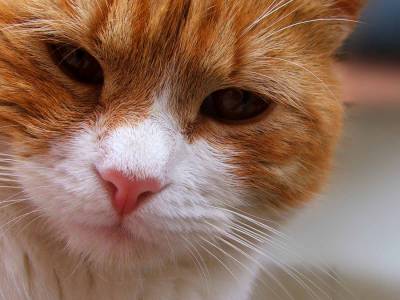
FUNGAL AND - the skin is inflamed, redness and changes in structure (tubercles, grooves) are clearly noticeable. The cat, in many (but not all) cases, develops severe itching, which usually intensifies in the evening. Sometimes the pet scratches the skin until it bleeds, rolls on the floor and gnaws at the affected areas, as if trying to catch a flea. The hair falls out locally, the bald patches are clearly defined. In the center of the bald patches, the skin is most inflamed, along the edges it can look practically healthy. Treatment: immunity support and a well-chosen remedy that kills the identified bacteria or fungus.
FLEA DERMATITIS is an allergic reaction to waste products and flea bites. In a cat, sores on the skin form within a few minutes after the bite - an itchy red seal. Hypersensitive cats develop a rash from crown to tail, scratch their skin until they bleed, become nervous, and lose their appetite. Treatment: Execan in half a cube once a day / five days, flea drops.
ALLERGIC DERMATOSIS - a reaction to an allergen contained in food. In most cases, the cat scratches itself for a long time, but looks healthy. When the allergen accumulates in sufficient quantity for an obvious reaction, an itchy rash appears on the skin. In case of acute reactions, the rash appears immediately, swelling of the paws, lips, eyelids, larynx may appear - in this case, you must immediately show the cat to the doctor. Treatment: the same Execan or equivalent plus diet. It is imperative to donate blood for an allergy test in order to know exactly what foods should be excluded from the cat's diet.
SEBOREA develops as a result of overactive sebaceous glands. The coat looks dirty the very next day after bathing, the base of the hairs sticks together. A cat has crusts on the skin - exfoliated scales plus sebum. Sometimes the discharge will form foul-smelling bumps and lumps. Complex treatment: cleansing the skin, changing the diet, gently degreasing the coat and skin. Excessive sebum production can be caused by hormonal imbalance or chronic illness, therefore, the pet must be examined completely.
OSTEOPHOLLICULITIS is a purulent inflammation of the sebaceous ducts and glands. Many skin diseases in cats, from staphylococcus to seborrhea, can provoke this ailment: the sebaceous gland becomes clogged, pus accumulates inside, an abscess forms on the skin, which eventually bursts and dries up. Treatment depends entirely on the cause, as determined by the veterinarian. Do not squeeze out pustules! If necessary, this will be done by a veterinarian under sterile conditions.
FOLLICULITIS - small pustules in the surface layers of the skin. There are many reasons for the occurrence, but most often it is or, penetrating into the smallest wounds on the skin of a cat (scratches, scratches, insect bites). Without treatment, it can turn into furunculosis - very painful purulent formations the size of a large pea. With folliculitis and furunculosis in a cat, yellow skin in the affected areas - pus accumulated under the skin is visible. Comprehensive treatment: diet change, immunostimulants, antibiotics, local treatment.
CARBUNCULOSIS - purulent inflammation of the sebaceous glands and hair follicles located nearby. At the initial stage, a small lump is formed, filled with pus. The pimple grows, tissue necrosis develops inside it. There may be several outlets - greenish-yellow pus flows out of them. Over time, the holes merge into one, forming a weeping painful ulcer. If left untreated, multiple skin ulcers in cats can kill your pet! Complex treatment: local treatment, antibiotics, supportive therapy.
Skin infection of a bacterial nature (Proteus, Pseudomonas aeruginosa, staphylococci, etc.). Initially, the cat scratches, then hard reddish lumps appear on the skin. Over time, papules increase and form, which open and dry out. Scabs on the skin of cats coexist with hard papules, growing and opening pustules, a heavy unpleasant odor emanates from the pet. Complex treatment: antibiotics, immunity support, diet therapy, local treatment.
ECZEMA - chronic inflammatory process, developing for many reasons: allergies, stress, infections, diseases of internal organs, etc. Often is seasonal in nature with exacerbations in spring / autumn. Dry and wet eczema are skin diseases in cats, in which it is necessary to carefully examine the pet. Symptoms range from itching and pinkish rashes to severe scratching, hair loss, or flaking of the skin.
SKIN CANCER - mutational changes in epidermal cells. Oncological diseases of the skin in cats can "disguise" as dermatitis or furunculosis, look like small "harmless" bumps or age spots. Diagnosis is based on biopsy results.
Whatever the symptoms, a visit to the vet is a must. A change in the condition of the skin is often a sign of a disease of internal organs, chronic infection, malfunctioning of one of the body systems, etc. systems.
Skin diseases are quite common in cats and are one of the most common reasons for visiting a veterinarian. Fortunately, health problems like these are in most cases easily curable. They can be caused by infections, allergic reactions, or malfunctioning of internal organs.
To remove fleas, you can use drops applied to the skin of the animal in the area of \u200b\u200b\\ u200b \\ u200bthe withers. It is recommended to buy such drugs in veterinary clinics, as in pet stores there is a higher probability of meeting a fake. You should also wash floors, carpets, and wash bedding - flea eggs can remain in all these places. Effective remedy prevention is also a special collar, especially for cats that are on the street.
Ringworm
Some ailments of pets can be dangerous for their owners. Human-borne skin diseases in cats are fungal infections that cause ringworm. It is advisable to start their treatment at an early stage. The main symptom of lichen is areas with fallen hair, which the cat scratches all the time. Another symptom is that the skin flakes off, forming dandruff.
For the treatment of lichen, antifungal drugs are used in the form of ointments, and, if necessary, tablets. If the cat has a long, thick coat, it should be trimmed. This is done so that the ointment can be applied to the affected skin. In advanced cases, baths with sulfuric lime are prescribed.
Acne (acne disease)
Inflammation of the sebaceous glands occurs in all breeds. But most often such skin diseases occur in Sphynx cats. Localization of rashes can be different. In sphinxes, eels are found at the base of the tail, on the back, abdomen, and also under the lower jaw. Acne looks like black follicles, sometimes redness is observed around them. In furry cats, this condition usually occurs on the muzzle.

Acne in the initial stages is treated with lavages. Moisten the affected area with warm water, lather with bactericidal soap, then rinse it off and wipe it off with a towel. In more serious cases, special chlorhexidine-based gels are used, which can be purchased at veterinarians.
Bacterial infections
Acne, like wounds and cuts, can lead to bacterial skin diseases in cats. Symptoms can vary depending on how the inflammatory process is going. With a dry type of disease, dense nodules and flaky crusts appear on the skin. The wet course of the disease is characterized by wetting of infected areas, redness and the formation of pustules.

Dry foci are treated with antibacterial agents "Miramistin" and "Levomikol". Wet areas are treated with drying sprays. If the inflammation persists, a course of antibiotics is prescribed.
Allergic skin diseases in cats: photos and treatment
Allergies in pets are not uncommon. The most common variant in cats is hypersensitivity to flea bites. Outwardly, such an allergy can manifest itself in the form of baldness of certain areas of the skin, itching, the appearance of spots, the color of which can vary from pink to dark gray.
Treatment in this case is to rid the pet of fleas. In this case, an allergic reaction will manifest itself for some time even after the disappearance of insects. The symptoms will finally disappear after 5-6 weeks.
In addition to fleas, animal allergies can be caused by food or external irritants. Such cases are more difficult to treat. After all, identifying an allergen is not so easy.
Atopic dermatitis
Allergic skin diseases in cats, caused by external factors, are manifested by reddening of the skin on which there is little hair. For example, on the stomach or on the pads. Then crusts and pustules appear. This reaction can be caused by contact with pollen, detergents, medicines etc.

Clinical tests are needed to determine which allergen is the cause of the dermatitis. When a source of skin irritation is found, the animal should be protected from it. If the allergen could not be determined, antihistamines are prescribed.
Food intolerance
Food allergies can also manifest as skin problems. The symptoms are the same as for atopic dermatitis. Food allergies are rare in cats. Therefore, even an experienced veterinarian cannot always quickly determine the cause of an animal's discomfort.
If the food allergy is well established, you will have to change the pet's diet. Another type of food or homemade food that includes meat and vitamin-rich foods can help treat allergic skin conditions in cats. Initial treatment may also include antipruritic agents if the animal itches a lot.
Ear mite
There are several types of mites that cause skin diseases in cats on the ears. You can get them on the street or through contact with other animals. A cat worried about ticks shakes its head and scratches its ear. Other symptoms appear. These include redness, hair loss, and a pungent dark discharge in the ear. Bacterial infections can have similar manifestations. Therefore, to establish an accurate diagnosis, the animal should be shown to the veterinarian.

For the treatment of ear mites, special preparations are used in the form of drops and ointments. It is also recommended to remove dark discharge with cotton wool or soft cotton cloth.
Psychogenic alopecia

Treatment consists of eliminating factors that cause stress in the cat. A mechanical barrier may also be required to prevent the animal from licking itself.
Cushing's syndrome
Skin diseases in cats caused by hormonal disorders are relatively rare. One such ailment is Cushing's syndrome. Its cause is the excessive production of the hormone cortisol by the adrenal glands. Certain medications can also cause illness.
An excess of cortisol has a negative effect on the entire body. But on the skin, the manifestations of the disease are especially noticeable. The coat becomes thinner, then bald spots appear. The skin becomes thin and vulnerable to mechanical damage. The wounds do not heal for a long time. The tips of the ears become flabby and curl.

Treatment can include various measures, depending on the cause and course of the disease. If Cushing's syndrome is caused by taking cortisol-containing drugs, they are replaced by others medicines... If the reason is adrenal hyperactivity, drug therapy is prescribed. Sometimes they resort to surgery. It is effective when only one adrenal gland is malfunctioning. In such a situation, its surgical removal can solve the problem.
The above are the most common skin conditions in cats. Photos and descriptions of symptoms in most cases allow you to make the correct diagnosis for your pet with high accuracy. However, treatment options should still be discussed with a veterinarian.
Hello! About a year ago, red scabs appeared on the neck of the cat under the fur, which she brushed very hard, but they periodically passed, then reappeared. A couple of months ago, the same ones appeared on their hind legs with inside, the cat scratches and licks them all the time. We went to the veterinarian, gave ointment with tar, but it did not help. About three weeks ago, we saw blotches of blood in the urine, how long I can't say, because before that, she went out into the street until it got cold. We went to the veterinarian, he said that she had these scabs due to a malfunction of the liver and kidneys, but urine analysis is not done here, but only a scraping from the skin was taken, they said that it was not shingles and not a tick. They give the cat injections with suprastin, some antibiotics, calcium, there is no improvement. After the injections, the cat runs around the house, saliva runs, behaves very strangely, then begins to move its hind legs poorly. All this time she is eating and drinking normally. What treatment is carried out in such cases, is such a reaction to injections normal? There is no other clinic here, and we are very worried about the cat, but we do not know how to help her.
Hello!
There can be quite a few reasons for the symptoms you describe. Describe in detail the diet of the animal, indicating the ingredients included in it. When did you perform routine deworming? When was the animal vaccinated and with what vaccine? What vitamin preparations do you use additionally? This is very important diagnostic information. Provide it soon.
Please note that feeding with Whiskas, Friskas, Meow, Felix and Kitiket is not recommended for feeding cats. Neither dry nor wet. These are very harmful feeds that can sooner or later provoke gastrointestinal diseases and quite often lead to the death of the animal. Sausages, milk, soups, borscht and everything else "what we ourselves eat" is not applicable for the nutrition of cats. This rule is. Feed your animal either quality commercial food: Acana, Gina, Orijen, Hills, Royal Canin, Eukanuba, Go Natural, or Now Fresh. Or natural products: rice, oatmeal, buckwheat + beef, turkey, rabbit (but not in the form of minced meat) and stewed vegetables (cabbage, cauliflower, carrots, beets). The percentage of meat in the main diet is at least 70%. Also remember that you should never mix natural food and industrial feed. Vitamins must be used for any type of food, for 1-1.5 months. 2 p. in year.
The animal has allergies and miliary dermatitis. Perhaps hypovitaminosis also has a significant effect on the manifestation of this kind of symptomatology. Treatment should be comprehensive.
- Instead of water - a decoction of chamomile 1 tsp. Boxes. for 1 liter of water - up to 7-10 days.
- White coal 1 tab or Ataxil 10-20 ml. ext. 2 p. in the village - up to 12 days in 60 minutes before or after eating and giving drugs vn.
- Nux Vomica 5 cap. for 1 tsp. water int. 3 p. in the village - up to 7-10 days.
- Mezim 1 tab. ext. 2 p. in the village - up to 10 days.
- Emprobio 4 ml int. 2 p. in the village in 30 minutes. before meals - up to 14 days. or Hilak 5-6 cap. 10 ml of water int. 2 p. in the village - up to 7-10 days.
- Salvikal or Vitabon up to 3 months according to the instructions
- Bathe the animal with TropiClean Oxy-Med Oatmeal Shampoo, removing all the crusts, then once every 1-2 months.
- Treat the affected areas with hydrogen peroxide 2-3 r. in d. to complete cleanliness up to 14 days.
- Local treatment with Chlorhexidine 3 r. in d. up to 14 days
- Lubricate the affected areas with methylene blue (alcohol solution) 2 r. in d. up to 12 days
- 20 minutes after item No. 10, lubricate the affected areas with Clotrimazole or Ekodax 2 r. in d. up to 12 days
- Wear a plastic veterinary collar that prevents self-injury up to 14 days.
- Suprastin 0.5 ml i.m. 2 p. in d. up to 12 days
- Lipoton 0.5 ml pc. 2 p. in d. up to 12 days
Inform about the condition of the animal once every 3-5 days.
